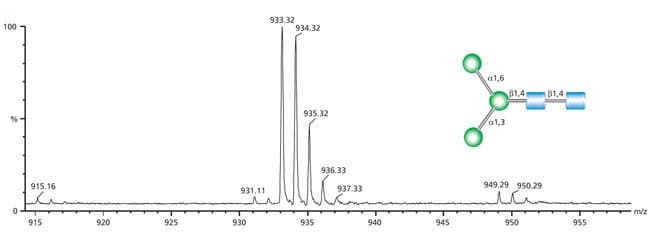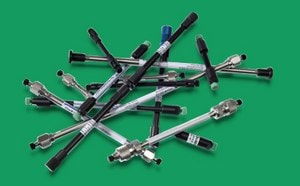Mass Spectrometry

Mass spectrometry (MS) is an analytical technique that uses mass-to-charge (m/z) ratio to identify compounds in a sample. The method identifies a compound by determining its molecular weight and analyzing its isotopic abundance. A mass spectrometer ionizes the sample into gaseous ions and then identifies the ions by their mass-to-charge ratios and relative abundances.
Featured Categories
Explore our selection of high-quality analytical reagents for wet chemistry, chromatography, spectroscopy, analytical, titration, water quality control, and electrochemistry.
Choose from classical TLC plates with silica, aluminum, glass, and plastic backings as well as HPTLC plates, MS-Grade TLC and HPTLC plates, and PLC plates.
Achieve precise separations with our extensive HPLC column collection. Enhance retention, resolution, and selectivity. Order today.
Today, mass spectrometry is a well-established detection method that offers a multitude of benefits, such as selectivity, sensitivity, and multi-sample analysis.
It can be coupled to various chromatographic techniques, such as liquid chromatography, thin layer chromatography, gas chromatography, or inductively coupled plasma. Mass spectrometry is widely used across many research fields and industries, including the pharmaceutical and food industries, health clinics, clinical research labs, and forensic and environmental testing labs.
How does mass spectrometry work?
A mass spectrometer works by converting individual molecules into ions and then analyzing the relative abundance of the generated ions. In the ion chamber of a mass spectrometer, each individual molecule is ionized to form a molecular ion, having one electron less than the parent molecule. Molecular ions, or ‘radical cations’, then undergo fragmentation into ions which, in turn, are further fragmented, and so on. From one complex sample, a mass spectrometer generates many ions. The ions are then accelerated in an electromagnetic field and separated based on their mass-to-charge (m/z) ratios. The instrument’s detector records the ions in proportion to their relative abundance and generates a mass spectrum of the molecule.
Applications of mass spectrometry
Due to the sensitivity of mass spectrometry, it is widely used to measure very low molecular weights at extremely low concentrations, below nanograms per milliliter (ng/mL). The ability to couple mass spectrometry to other separation techniques such as capillary electrophoresis, GC, and HPLC makes it a versatile analytical tool for the simultaneous separation and identification of analytes.
Typical applications of mass spectrometry include:
- Analysis of amino acid sequences of proteins and peptides
- Evaluation of impurities during drug development
- Purity assessment of active pharmaceutical ingredients
- Routine analysis of illegal drugs in urine, blood and hair
- Detection of hereditary disorders of amino acid, fatty acid, and organic biosynthesis
Visit our document search for data sheets, certificates and technical documentation.
Related Articles
- Learn more about Mass Spectrometry or MS including what it is, what it is used for and how it works.
- We present a fast and robust HPLC-MS/MS method that can be used for Remdesivir and three structural antiviral analogues
- One of the most important aspects of our ultra-pure MALDI matrix substances is their ability to dissolve rapidly and completely; a brief vortex mixing is typically sufficient.
- See the data showing how Milli-Q® ultrapure water meets the stringent purity requirements for reliable trace element analyses of environmental samples.
- Elemental impurities in pharmaceutical drugs present a risk to human health and are regulated. Milli-Q® ultrapure water purification systems comply with the requirements for trace element analyses.
- See All (67)
Related Protocols
- An optimized LC-MS/MS based workflow for low artifact tryptic digestion and peptide mapping of monoclonal antibody, adalimumab (Humira) using filter assisted sample preparation (FASP).
- A step-by-step protocol for released N-linked glycan analysis of the monoclonal antibody adalimumab, based on UHPLC-FLR-MS and procainamide labeling.
- A complete workflow for the intact and middle-up mass analysis of reduced and non-reduced monoclonal antibodies based on SEC-MS with sample preparation by protein-A affinity clean-up.
- IFRA method introduces new CRMs for allergenic fragrances, analyzed by GC with ionic liquid capillary column for selectivity.
- Alkylphenols are used in various industries like paper manufacturing and pesticide formulations.
- See All (71)
Find More Articles and Protocols
How Can We Help
In case of any questions, please submit a customer support request
or talk to our customer service team:
Email custserv@sial.com
or call +1 (800) 244-1173
Additional Support
- Chromatogram Search
Use the Chromatogram Search to identify unknown compounds in your sample.
- Calculators & Apps
Web Toolbox - science research tools and resources for analytical chemistry, life science, chemical synthesis and materials science.
- Customer Support Request
Customer support including help with orders, products, accounts, and website technical issues.
- FAQ
Explore our Frequently Asked Questions for answers to commonly asked questions about our products and services.
To continue reading please sign in or create an account.
Don't Have An Account?


